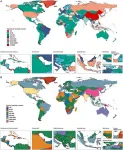(Press-News.org) Researchers at Oxford University have developed a new method to extract fluorine from fluorspar (CaF₂) using oxalic acid and a fluorophilic Lewis acid in water under mild reaction conditions.
This technology enables direct access to fluorochemicals, including commonly used fluorinating agents, from both fluorspar and lower-grade metspar, eliminating reliance on the supply chain of hazardous hydrogen fluoride (HF).
The findings are published today in the journal Nature.
Currently, all fluorochemicals – critical for many industries – are generated from the highly dangerous mineral acid hydrogen fluoride (HF). This acid is produced in a high-energy process whereby naturally occurring fluorspar (CaF2) is reacted with concentrated sulfuric acid under very harsh conditions. Despite stringent safety regulations, HF spills have occurred, sometimes causing fatalities and detrimental environmental effects.
A team in Oxford has now demonstrated that the fluorine content of acid grade fluorspar (>97% CaF2) can be harvested in water under mild reaction conditions in the presence of a fluorophilic Lewis acid and oxalic acid serving as Brønsted acid. This follows previous work from the team into solid-state activation of fluoride using mechanical energy.
Their new aqueous reaction pathway is adaptable, depending on the Lewis acid used. With boric acid, the process affords an aqueous solution of tetrafluoroboric acid, that was successfully applied to Balz-Schiemann chemistry. When silica is used instead of boric acid, this scalable process carried out at room temperature provides direct access to aqueous hexafluorosilicilic acid that can be converted into commonly used nucleophilic fluorinating reagents such as potassium fluoride and tetraalkylammonium fluoride salts.
This work represents a new departure for the production of fluorochemicals from fluorspar, as well as lower-purity metspar, because the protocol does not rely on the complex supply chain of hazardous hydrogen fluoride (HF). Considering current efforts to prepare oxalic acid at low cost from CO2 and biomass, the method may become a viable alternative to the traditional sulfuric acid-dependent HF pathway.
Dr Simon Immo Klose, formerly at the University of Oxford and now at Columbia University (USA), and one of the lead authors of the study, says:
“The most challenging aspect of using fluorspar as a fluoride source is its high stability and low solubility. Unlike table salt, which dissolves readily in water, only a tiny pinch of fluorspar would dissolve in the same amount of water. But, like pulling a thread to unravel an entire sweater, if we can continually remove this tiny amount, we can dissolve kilograms of calcium fluoride under mild conditions, despite its low solubility.”
Dr Anirban Mondal, from the Department of Chemistry, University of Oxford, and one of the lead authors of the study, says:
“HF-related accidents serve as a constant reminder of the hazards involved in traditional fluorochemical manufacturing. With our technology, however, we can directly access all the commonly used fluorinating reagents from fluorspar without having to rely on HF and its hazardous supply chain. It is incredibly rewarding to be part of a team working on such a practical, real-world problem with a solution that will immediately have an impact.”
Calum Patel, formerly at the University of Oxford and now at FluoRok (UK), and one of the lead authors of the study, says:
“Our first mechanochemical method disclosed in 2023 [Science] led to a new reagent that was studied for its ability to serve as nucleophilic fluoride. We have taken a significantly different, yet complementary approach to processing fluorspar into well-known industrially important fluorinating reagents. Remarkably, fluorspar can be activated in water at low temperature through the cooperative action of oxalic acid and a Lewis acid. This process enables us to access broader classes of fluorochemicals from fluorspar without the need to manufacture HF, such as structurally diverse fluoroarenes used to synthesise agrochemicals.”
Lead author Prof Véronique Gouverneur FRS, Department of Chemistry, University of Oxford, who conceived and led this study says:
“A solution to use CaF2 directly for fluorination chemistry, without the need for HF production, has been sought for decades. This study represents an important step because the protocol developed in Oxford is easy to implement and does not require specialized equipment. It can therefore be used anywhere in academia and industry, minimising carbon emissions by avoiding HF manufacture and enabling supply localisation.”
ENDS
“Fluorspar to fluorochemicals upon low-temperature activation in water”, DOI: 10.1038/s41586-024-08125-1, will be published online in Nature at https://www.nature.com/articles/s41586-024-08125-1 from 16:00 UK time 13 November 2024, and can be accessed under embargo by journalists through Springer Nature’s press site in the usual way.
Journalists can contact:
Dr Anirban Mondal, anirban.mondal@chem.ox.ac.uk
For all other press queries please contact Dr Thomas Player (Communications Manager, Department of Chemistry, University of Oxford) on chemistry-news@chem.ox.ac.uk
About the University of Oxford
Oxford University has been placed number 1 in the Times Higher Education World University Rankings for the ninth year running, and number 3 in the QS World Rankings 2024. At the heart of this success are the twin-pillars of our ground-breaking research and innovation and our distinctive educational offer.
Oxford is world-famous for research and teaching excellence and home to some of the most talented people from across the globe. Our work helps the lives of millions, solving real-world problems through a huge network of partnerships and collaborations. The breadth and interdisciplinary nature of our research alongside our personalised approach to teaching sparks imaginative and inventive insights and solutions.
Through its research commercialisation arm, Oxford University Innovation, Oxford is the highest university patent filer in the UK and is ranked first in the UK for university spinouts, having created more than 300 new companies since 1988. Over a third of these companies have been created in the past five years. The university is a catalyst for prosperity in Oxfordshire and the United Kingdom, contributing £15.7 billion to the UK economy in 2018/19, and supports more than 28,000 full time jobs.
About the Department of Chemistry, University of Oxford
The department’s mission is to advance the global understanding of chemistry, and to use that knowledge to address major challenges for society. Find out more at www.chem.ox.ac.uk
END
In sickness or in health, the billions of microorganisms that inhabit our guts are our constant companions throughout life. In the past few decades, scientists have shown how the nature of this ‘microbiome’ can provide valuable clues to human diseases and their treatment.
A new study from the Bork group at EMBL Heidelberg, recently published in the journal Cell, reports that a number of conditions, such as lifestyle and disease, affect the total number of microbes in the gut, making this often neglected metric one that bears ...
An international team led by the University of Geneva (UNIGE) has identified three ultra-massive galaxies – nearly as massive as the Milky Way – already in place within the first billion years after the Big Bang. This surprising discovery was made possible by the James Webb Space Telescope's FRESCO program, which uses the NIRCam/grism spectrograph to measure accurate distances and stellar masses of galaxies. The results indicate that the formation of stars in the early Universe was far more efficient than previously thought, challenging existing galaxy formation models. The study is published in Nature.
In the theoretical model favored by scientists, galaxies form ...
EMBARGOED by JAMA Network Open until 11 a.m., ET until Nov. 13, 2024
Contact: Gina DiGravio, 617-358-7838, ginad@bu.edu
(Boston)—Burnout is a public health crisis that affects the well-being of physicians and other healthcare workers, and the populations they serve. Burnout is characterized by emotional exhaustion, cynicism, lack of motivation, and feelings of ineffectiveness and inadequate achievement at work. Past studies have shown that compared to the general working U.S. population, physicians ...
An international team that was led by the University of Geneva (UNIGE) and includes Professor Stijn Wuyts from the University of Bath in the UK has identified three ultra-massive galaxies – each nearly as massive as the Milky Way – that had already assembled within the first billion years after the Big Bang.
The researchers’ results indicate that the formation of stars in the early Universe was far more efficient than previously thought, challenging existing galaxy formation models.
The surprising discovery – described today in the journal Nature – was made by the James Webb Space Telescope (JWST) ...
The secrets of fossil teeth revealed by the synchrotron: a long childhood is the prelude to the evolution of a large brain
Could social bonds be the key to human big brains? A study of the fossil teeth of early Homo from Georgia dating back 1.77 million years reveals, thanks to the European Synchrotron (ESRF) in Grenoble, a prolonged childhood despite a small brain and an adulthood comparable to that of the great apes. This discovery suggests that an extended childhood, combined with cultural transmission ...
A new joint study by the University of Eastern Finland and Karolinska Institutet in Sweden found that the GLP-1 agonists semaglutide and liraglutide, which are used for treating diabetes and obesity, were associated with fewer hospitalisations among individuals with alcohol use disorder, AUD. Fewer hospitalisations were observed for alcohol related causes, substance use related causes, and for physical illnesses. However, no association was observed for hospitalisations due to attempted suicide.
Effective treatments for alcohol dependence exist; however, they remain underused and are not effective, or suitable, for all patients with alcohol or substance use disorder. Previous ...
With hospitals already deploying artificial intelligence to improve patient care, a new study has found that using Chat GPT Plus does not significantly improve the accuracy of doctors’ diagnoses when compared with the use of usual resources.
The study, from UVA Health’s Andrew S. Parsons, MD, MPH and colleagues, enlisted 50 physicians in family medicine, internal medicine and emergency medicine to put Chat GPT Plus to the test. Half were randomly assigned to use Chat GPT Plus to diagnose complex cases, while the other half relied on conventional methods such as medical reference sites (for example, UpToDate©) and Google. The researchers then compared the resulting ...
Extreme weather spurred by climate change, including droughts and heavy rains, may increase the risk of nitrates from fertilizers ending up in groundwater, according to a recent study from researchers at the University of California, Davis. The study found heavy rains after a drought caused nitrates to seep 33 feet under farm fields in as little as 10 days. The study was published in Water Resources Research.
“The conventional wisdom was that it could take several weeks to years for nitrates to move from the crop root zones to reach groundwater,” said corresponding author Isaya Kisekka, a professor in the Departments ...
Background and Aims
Liver cancer is a digestive system malignancy that poses a significant public health challenge globally. This study aimed to analyze and compare the epidemiological trends of liver cancer attributed to hepatitis B (LCHB) and alcohol use (LCAL) over the past 32 years.
Methods
Data on mortality and disability-adjusted life years for LCHB and LCAL in China, globally, and across five sociodemographic index regions were obtained from the Global Burden of Disease 2021 database and comprehensively ...
One only needs to glance at the news, social media, or even just out the window to understand the devastation caused by flooding. Recent back-to-back major hurricanes have brought catastrophic rainfall that has devastated communities across the southeastern United States.
With climate change, experts predict these extreme weather events will increasingly become the norm. Among the many ways that researchers are devising strategies to protect and assist vulnerable areas, one such effort involves increasing the speed and accuracy of damage assessments.
“Research ...






